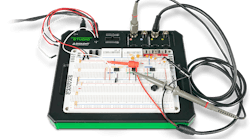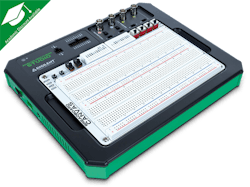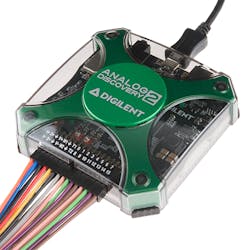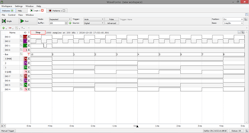I’ve had the pleasure of using National Instruments' (NI) ELVIS III for a while now. It’s a robust platform designed for college and developers who can take advantage of NI’s CompactRIO functionality as well as the MeasurementsLive and training/educational tools that are part of the bundle. Of course, the system comes at a premium price, which can be easily justified for many institutions, but sometimes a lower price alternative may meet the needs of many.
Digilent’s Analog Discovery Studio (ADS) is one of those platforms (Fig. 1). It’s priced at $599, so you can pick up quite a few for the price of one ELVIS III. Of course, it lacks features such as the CompactRIO support, but ADS’s built-in test-and-measurement systems provide similar functionality. Likewise, ADS includes a removable patch board that allows a system to be used by more than one person or groups. The biggest difference in this instance is that the ADS patch board has a simple connection on the back for power, while the ELVIS III can recognize what patch-board system is installed and its capabilities.
But enough about the ELVIS III.
1. Analog Discovery Studio has a removable patch panel and integrated, USB-based test-and-measurement systems.
ADS offers the same test and measurement functionality as its sibling, the Analog Discovery 2 (Fig. 2). This is a USB-based system with over a dozen peripherals, including a dual channel oscilloscope, a dual-channel waveform generator, a 16-channel logic analyzer, a protocol analyzer, a spectrum analyzer, and configurable power supplies. The oscilloscope channels have a 30-MHz bandwidth, and the 14-bit ADCs maintain a 100-Msample/s capture rate. The input channels are shared by voltmeter, data-logger, spectrum-analyzer, network-analyzer, and impedance-analyzer instruments. Only one can be used per channel at a time.
2. Digilent’s Analog Discovery 2 provides the same test-and-measurement support as ADS.
The waveform generator has 14-bit DACs that can deliver 100 Msamples/s, while the logic analyzer can capture up to 100 Msamples/s. These are independent of the oscilloscope. The logic analyzer supports 3.3- and 1.8-V inputs, while the waveform generator supports scripting; there’s a scripting editor provided with the system, too.
The systems are supported by the Waveforms software (Fig. 3). Waveforms run on Windows, Linux, and MacOS. I tried it out on Windows and Linux and didn’t notice any differences. In addition, a software development kit (SDK) supports Python, C++, C#, and Visual Basic. I haven’t tried that out yet nor the third-party toolbox support for software such as MathWorks’ MATLAB and National Instruments’ LabVIEW. I’m hoping to check out the LabVIEW support in the future, since I have it installed for the ELVIS III.
3. ADS is supported by the Waveforms application that manages the USB-based test-and-measurement peripherals.
Setup is quick—it’s just the Waveforms application and the USB connection and configuration. Waveforms is on par with other USB-based test-and-measurement systems I’ve used.
The biggest challenge for swapping the patch board is that all of the test-and-measurement cables must be removed. That’s true of most other systems, even the ELVIS III. The ADS comes with cables for the logic analyzer and wired probes for the other test equipment. BNC cables are optional, but I had these handy from other systems. These worked sufficiently since the bandwidth of the ADS peripherals is well under a GHz.
The patch panel includes some useful interfaces like buttons, switches, and LEDs. If a simple patch panel is all you need, then I would recommend going with the Analog Discovery 2, which is almost half the price of the ADS. I would recommend the ADS for educational institutions, because it provides a more consistent platform that’s easier to work with.
Both platforms are a good complement for developing peripheral systems for devices like the Raspberry Pi or Arduino. They can easily deal with interfaces like SPI and I2C as well as the analog support these platforms can handle.




